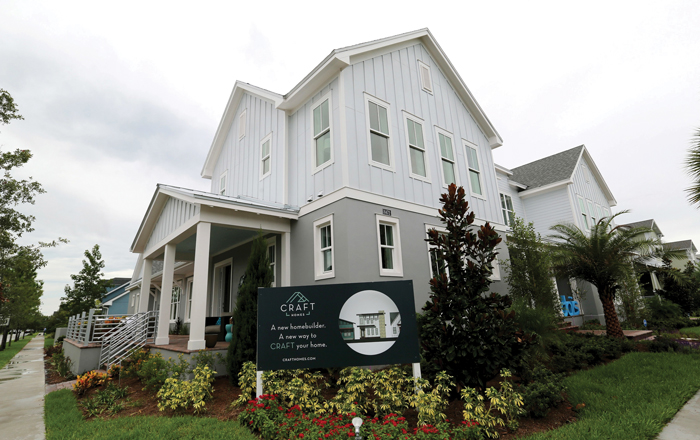
WHIT is an acronym for Wellness Home Built on Innovation and Technology. Located in Laureate Park, it’s open for tours.
STEP INTO THE FUTURE
A showcase home in Lake Nona is taking that community’s wellness emphasis a step further by demonstrating how technology can help residents monitor and improve their health in everyday life.
In this smart home — called WHIT (Wellness Home Built on Innovation and Technology) — the island countertop in the kitchen helps you make healthful meals.
Plus, the air is purified in six stages to help you breathe. The therapeutic aroma generated in the living room is designed to help you stay calm, while in the home office the aroma helps you focus.
WHIT, a townhome in Laureate Park by Craft Homes, is a project of the Lake Nona Institute, the nonprofit think tank housed in the Tavistock-created community. It’s open to visitors for interactive tours without charge.
The institute planned and outfitted the home with nine corporate partners. Some of the features are prototypes; others are in the marketplace. Part exhibition and part laboratory, WHIT is one way the institute is evaluating wellness technologies for Lake Nona and beyond. “We want to see what moves the needle in health and wellness,” says Gloria Caulfield, the institute’s executive director. “What are the scalable solutions in a variety of different environments? They have to be cost-effective and applicable everywhere, not just in Lake Nona. “If the kitchen is the heart of today’s new homes, then the prototype interactive island designed by GE Appliances is the heart of the WHIT kitchen.
The large “intelligent surface” of the island helps users plan, cook and shop for nutritious meals. GE designed the interactive island with input from Lake Nona residents. It incorporates family members’ food preferences and dietary needs.
In the kitchen and elsewhere, many of WHIT’s health features work in the background. Cork flooring, for example, was chosen because it’s antimicrobial, resistant to mold and easy on the feet. Air and water purifiers filter out pollutants, and the home’s insulation offers a higher-than-usual level of sound protection.
In every room, there are gadgets galore.
- • Using “predictive analytics,” a wearable sensor called the CarePredict Tempo can help identify changes in the activities of older people that might signal a health concern. A weight sensor in pill containers helps track whether a patient has kept up with his or her medication. Germ-killing UV lights in one of the bathrooms work to kill germs.
- • CareConnect from Nemours, which operates a children’s hospital in Medical City, allows kids to see a pediatrician via interactive video, using an iPad or other device. A special thermometer gives doctors reliable readings, and various products help residents manage conditions such as diabetes and asthma.
- • Circadian lighting by Delos provides levels of light that follow the body’s natural patterns — without a blast of harsh light if you wake up at 3 a.m., to go to the bathroom, for example.
Delos, a research and consulting company, “curated” numerous other products for the home, and they’re available at its online StayWell shop.
Those include air purifiers and aromatherapy machines; a vitamin C shower-head infuser that reduces chlorine in the water for softer skin and hair; and advanced memory-foam mattresses that don’t have the objectionable fumes often associated with that material.
Peter Scialla, the company’s chief operating officer, says Delos has had a longstanding partnership with Lake Nona that includes StayWell rooms in the two hotels at the Lake Nona Town Center. WHIT should provide “a lot of market insights on which of these [features] are attractive to consumers,” Scialla says.
Sensor technology is gradually making it possible for devices in the home to respond to the people who live there, he says. Adds Scialla: “We’re close to an environment that can read the human body.”
Still, WHIT doesn’t rely on digital technology alone. Part of the home is a throwback to a simpler time when people produced and prepared their own food. A courtyard off the kitchen doubles as a stress-reducing meditation space and garden.
Although the institute spent two years developing WHIT, in some ways it’s just getting started. The garage behind the house will serve as an ongoing laboratory for home wellness innovation in collaboration with UCF.
“Many other companies have had great products start in the garage,” Caulfield notes. “We have a white, blank canvas to do that in.”
Caulfield says WHIT will be ever-changing: “We don’t want it to be static, and we don’t want it to be a museum. If you come back in six months or three months, you’re going to see different things.”
VISITING WHIT
WHIT is open to visitors free of charge by request. Visit MeetWhit.com to make an appointment. The home is located across from the Laureate Park Village Center at 8464 Tavistock Lakes Boulevard.
In addition to the builder, Craft Homes, partner organizations that contributed to the project include American Well, Dais, Delos, GE Appliances, GuideWell, Nemours Children’s Health System, Sustainable Synergy, Technogym and the UCF College of Medicine. Go to meetwhit.com for more information.
